After last week’s intense activities centred on Rosetta’s lander Philae and its descent to the surface of Comet 67P/Churyumov-Gerasimenko, it’s time to take another look at this beautiful comet through Rosetta’s navigation camera.
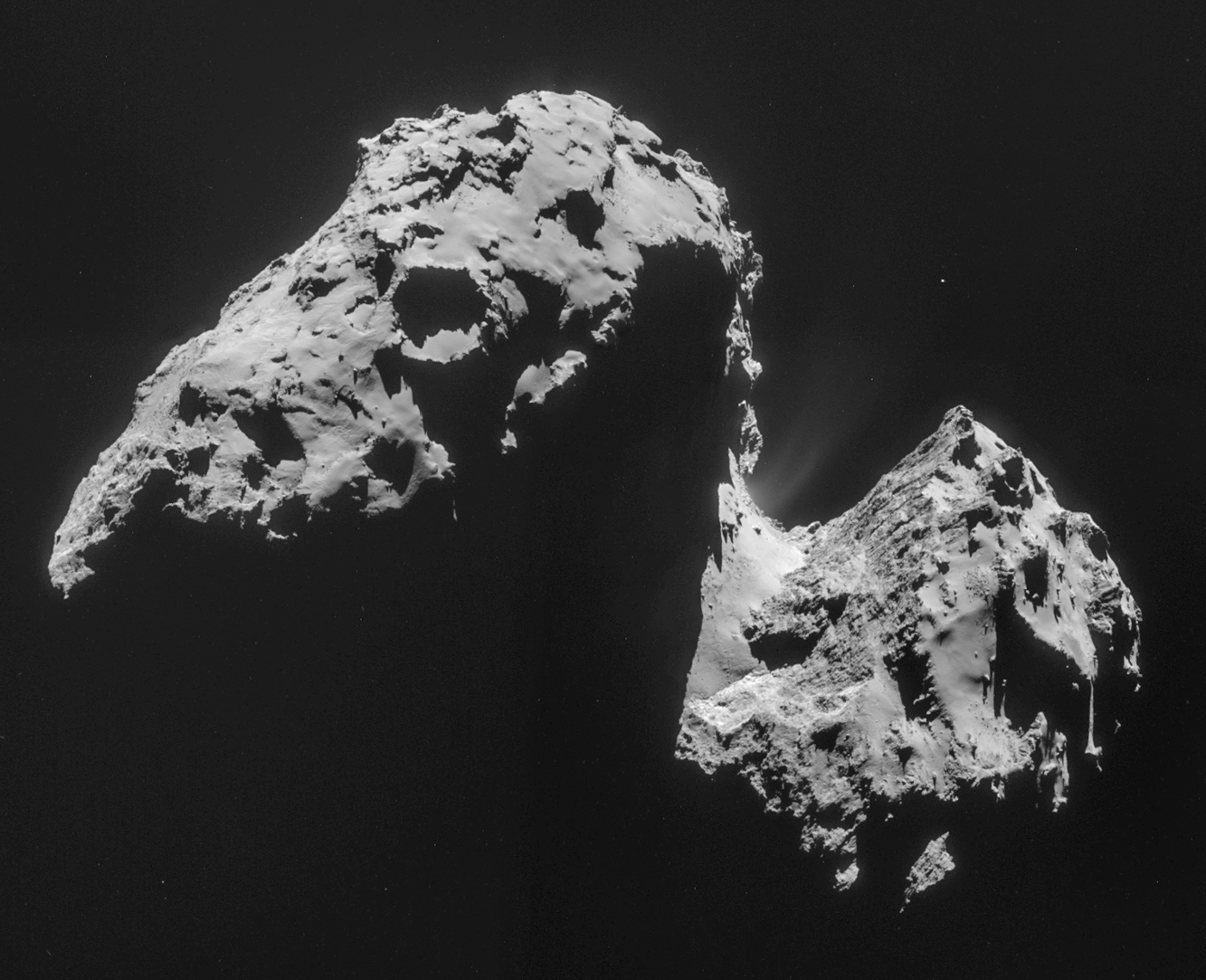
Four image NAVCAM mosaic comprising images of Comet 67P/C-G taken on 17 November. Credits: ESA/Rosetta/NAVCAM – CC BY-SA IGO 3.0
This NAVCAM mosaic comprises four individual images taken on 17 November from a distance of 42.0 km from the centre of Comet 67P/C-G. The image resolution is 3.6 m/pixel, so each original 1024 x 1024 pixel frame measured about 3.7 km across. The mosaic has been cropped (but not rotated) and measures roughly 5.0 x 4.1 km. Some slight contrast enhancement has also been applied.
Due to rotation and translation of the comet during the image taking sequence, making a mosaic involves some compromises. However, as always, the individual images have also been made available below to allow you to check the accuracy of the mosaicing and intensity matching.
Framed between the larger lobe of the comet on the left and the smaller one on the right, the ‘neck’ of the comet appears in full glory, showing the highly textured cliffs on the smaller lobe, above the neck, and traces of activity stemming from the neck. A number of small white blobs also appear in the image, likely specks of dust or other small objects in the vicinity of the comet.

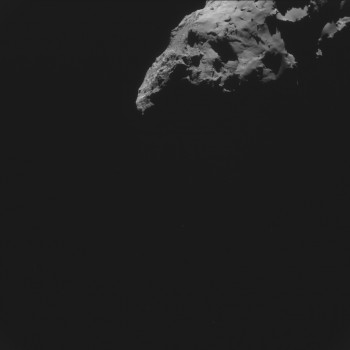
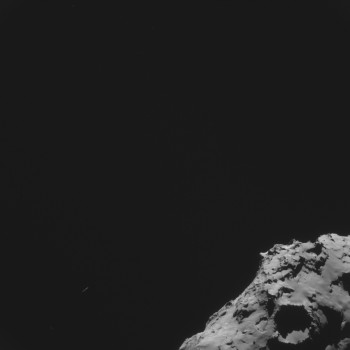
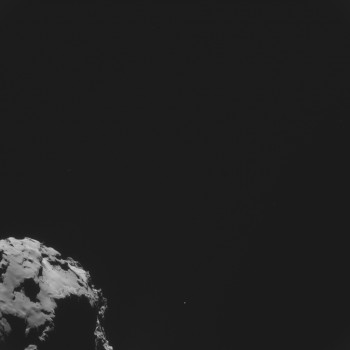
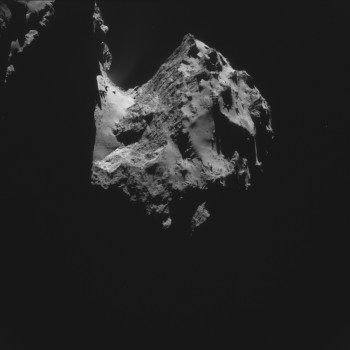








Discussion: 76 comments
thanks, really enjoyed the PBS show here in the states last night.
The “highly textured cliffs on the smaller lobe” have indeed never been so strikingly apparent as in this image which highlights, in particular, the extraordinarily wide-scale, consistent stratification of the rock face over around two kilometres width and a kilometre height.
As for the “traces of activity stemming from the neck”, they clearly emanate from those enormous “white”-topped boulders to be seen at the further end of the neck region.
Again, how does the standard “sublimating ice” theory account for the fact that the most intense activity is invariably focused on this neck region which is necessarily much more often in shade due to the flanking enormous cliffs, than the two lobes are?
One possibility is the material in the “neck” is different, and more likely to sublimate. If the structure was formed by two objects “sticking together” loosely by gravity, any material in the center was previously loose and “flowed” into the void. Snow vs ice, if you will.
But is the sublimation posible at this distance from the sun and in this particular part of the comet?
…and most important thing do you see dirty snowball there?
According to ESA comet is dark like coal
Sublimation: Yes it can happen out there. All depends on the phase diagramms of the materials involved. Don’t forget there is vacuum outside there. Which means pressures far beyond 1 mbar.
E.G. At 1013 mbar CO2 will sublimate at about – 78°C
For water sublimation can occur even close to absolute zero if the pressure is low enough.
Check out and google for “Phasediagrams” of water or other substances. They give you a good impression of the conditions under which sublimation can occur. Very often people forget that it is a pretty good vacuum out there.
For the Dirty snowball: First of all, the dirty “snow ball” was coined to give a nice handy picture for the assumption comets would consist of water ice and other volatile substances like CO2 plus dust/rock /stones. I myself never pictured an earth made snowball with some stones (but that is my personal picture). I have never tried this, but making a snow ball from dry very fine grained snow and adding 30% of mixed coal/sand dust wood not result in a white snow ball I believe.
The probability of
1/ two tiny objects gently meeting each other and then “sticking together” by gravitational attraction, and
2/ of Man chancing to send the Rosetta probe to visit precisely this particular virtually impossible object out of the hundreds of millions of potential comets which are theorized to exist
is not even vanishingly small. It is literally zero.
Since no one else has pointed this out that I know of, if the “neck” is the result of material removal by whatever means which has cut p67 into its current two lobe shape, then the sides of the cliffs on either side of the neck ARE the interior of the comet.
😉
As in the wood, could be structural differences in there.
@ Sovereign Slave
I totally agree. This has always been implicit in my various posts on different threads arguing that the “neck” region has been electrically machined by discharge activity, which focuses preferentially on what started out as the “waist” region of the elongated, potato-shaped object 67P originally was. The “waist” region already observed on other comets (as on certain asteroids) has now become a “neck” on 67P simply because the machining process has either been going on for longer or it has been more intense.
Those towering cliffs of stratified rock are indeed the interior of the comet. 67P is rock through and through.
Again: How can a theory that cannot not even explane the movement of the bodies in the solar system (including Rosetta’s trajectory to the comet) account for anything?
The most beautiful NAVCAM mosaic up to now! No words…
The ‘trench-iness’ of the neck is so obvious here.
Good luck to the folks trying to explain it is all I can say, Logan. If it’s entirely the result of preferential erosion, that would mean that 60 years ago before its orbit changed there may not have been a trench at all, and the chances of 67P staying in one piece for more than 1 or 2 more trips round the sun would seem pretty slim. The volatility of the neck region does seem to be significantly greater than the rest of the comet, but why only for two thirds of the circumference? The backside does not appear to have eroded any more than the rest of the comet.
Interior collapse of the porous innards of the comet doesn’t seem to be the answer either, because of the solid and non porous appearance of the giant cliffs. Although it might still be viable if the mechanism for creating the solid looking crust primarily involves exposure to cosmic and thermal radiation. It depends on how quickly the surface layer of dark organics forms and their insulating and binding properties.
The contact binary scenario is still being discussed as a real possibility as well, judging from the list of abstracts for the AGU event kindly posted earlier. I think it may be a case of, if there is insufficient evidence to say its definitely one or both of the first two, the contact binary is the most likely scenario left. That is if we discount a Googolplex voltage electric discharge, or alien comet mining ice worms as the cause. 😉
Don’t dismiss the alien mining ice worms completely. My favoured theory involves alien intelligent giant amoeba controlling the comet from within. The alien mining ice worms are their minions, engineering a neck stretch operation to enable reproduction by amoebal “fission” of the comet into its Churyumov/Geramisenko sub comets.
Totally irrational theory Marco, but I like it. 😉
Hi Robin. The head side of the neck have at least 4 ‘drains’ which are replenishing the neck’s deposit. As you, don’t believe the neck will survive even this perihelion.
If preferential emotion were the explanation for the neck it would seem that 67P might only survive a couple more trips round the Sun, but there seems to be more to it than that, so who knows how long it will survive as a single object, or if it splits, if it will recombine?
Oops! Erosion, not emotion.
Hi Robin.
“…because of the solid and non porous appearance of the giant cliffs”.
Think the reason is that we are seeing structural surfaces.
That could be the explanation certainly Logan, but then we are talking an awful lot of empty space within the comet nucleus to maintain such a low density, possibly two icy “geodes” forming the two lobes. That would take some explaining.
Think of the Titanic when found. Seen from the upside didn’t look that corroded.
Robin, you say “The backside does not appear to have eroded any more than the rest of the comet.”
So far, we have only seen those “sides” of the neck region which are visible in sunlight and they are deeply eroded. If, by the “backside” you mean the area on the night-side, we can as yet form no opinion, since the topography of the night-side will remain unknown for several months more, until 67P swings around the other side of the Sun, with Rosetta hopefully still taking pictures of it.
Do we know why the comet has formed in this odd shape, with a neck between the two lobes? Is it simply the case that the material in that portion of the comet has “eroded” faster than the rest? If so, has anyone done an analysis of if or when this erosion might cause the comet to break into two pieces?
@Rich
I was asking myself the same question but when I see the pics like the one of this post, the area with the most intense evaporation activity (or “sublimation” in this case ?) is always the neck.
Maybe Chury originally formed with a “normal” sphere shape BUT with more ice around its equator for instance (don’t ask me if and how this could be possible).
It this case, each time the nucleus of the comet passes near the Sun, the evaporation is more important around the “ring” of the equator than at the poles and finally gives this strange shape like an apple from which you eat the flesh and then remains the core with bigger extremities than the middle…
Nobody “knows”. We can only make suppositions. I have already posted my own: https://blogs.esa.int/rosetta/2014/10/29/cometwatch-26-october/#comment-140349, in support of the EU contention that the hour-glass shape seen here is a literally universal mechanism powered by multi-scale electrical activity
Interesting supposition, this electronical and EDM theory.
Could you please provide references to the relevant peer-reviewed papers. I’d love to read them.
Please?
–Bill
Hi Bill, As you presumably know, the “peer-review” system is totally controlled by Establishment science, (whatever the branch of science concerned). It is hence literally unthinkable that any paper showing the slightest dissent from standard theory (let alone papers on the alternative EU model) be published in any of the Establishment journals.
EU proponents publish instead mainly in the IEEE Transactions on Plasma Science, where you will find all you need. You can also visit three websites: Thunderbolts.info, Holoscience.com and https://electric-cosmos.org, among others. I recommend too the writings of on of the founding fathers of plasma physics, the Nobel Prize winner Hannes Alfvén.
Can you please make the colour of your text to be as black and white? For some reason your text is half-black. It is difficult to read your writings.
I agree! The text on this whole site is grey. The lack of contrast between the background and the text makes it very difficult to read.
I have to agree with the text being hard to read,
now as you say that, it really is, and now when i think about it, it is really hard to read, with all that white
+1 for Black Font.
Rosetta Navcam… the Gift that Keeps on Giving.
Enhanced Polar dust jets, 17 November 14:
https://univ.smugmug.com/Rosetta-Philae-Mission/Rosetta-Dust-Jets/i-G4GVZBs/0/L/Comet_on_17_November_NavCam–enh3-L.png
–Bill
It is also noticeable in this image the aura or halo created by sublimation at lower rates over the rest of the comet is more evident than the images taken a few weeks ago by NAVCAM from this distance. Some of the sublimation zones look to be on the point of becoming jets. It looks like 67P is just coming to the boil as previous observations predicted. Another picture from ESO of the comet’s tail would be nice, I would wager it is a lot more than 19,000 Km long now.
Thanks Claudia for those incredible pictures!
Very curious white balls, like two igloo close to each other, can be seen in the neck picture of the comet!
Maybe some kind of habitation for Philae to get some rest 😉
It is a common image artifact = it’s not realle there – sorry
Really…
The images from Rosetta are absolutely stunning !
Especially when we can see gas jets.
For the fist time in space exploration history, we can discover a “world” which looks like, in a certain way,….Earth !
Not a “flat” surface or “roundish” mountains, such as on the Moon, Mars, Venus or asteroids, but with real “peaks”, “mountains” and “canyons”. Breathtaking !
I was so amazed by this that I made a “tribute” to Rosetta & Philae : https://www.youtube.com/watch?v=B81jrqaNOYs
GREAT JOB ESA !
😉
What a nice HEXEGON crater, now how could that form?
@Dave “What a nice HEXEGON crater, now how could that form?”
Great observation, Dave! Hexagonal craters have been frequently observed on the rocky planets and moons. The poles of Saturn also display an enormous hexagonal shape in the swirling gas clouds.
Standard “impact crater” theory has no explanation to offer. See an EU explanation here: https://www.thunderbolts.info/thunderblogs/archives/goodspeed08/012708_hexagonal_craters.htm
Polygonal craters– they are an expression of the “fabric” of the underlying rock. In many cases, and probably this one, too, caused bay a system of three fracture systems.
–Bill
Thanks Bill
I have seen it in small scale, giants cause way, but not in the crater form. All the volcanoes I have seen and any meteorite impact I have even seen pictures of, looks roundish, Nothing like these large hexegons on earth that I have seen anyway.
Do you mean rocks made of various ices, or rocks made of water ice and grit, or do you mean rock.
regards
@Bill “Polygonal craters– they are an expression of the “fabric” of the underlying rock. In many cases, and probably this one, too, caused bay a system of three fracture systems.”
Bill, is this your personal theory or something which is actually part of standard theory?
In the latter case, could you please provide references to the relevant peer-reviewed papers. I’d love to read them.
I love your processed pictures, by the way, and sincerely appreciate all the work you’re putting in. You’re providing real grist to the mill!
I’d say “heptagonal-roundish”
Hex or sept?
Due to the observed activity/emision It is likely in the “neck” region the low-density material (porous ice?) is exposed. Although not clear why this -presumably-erosion happen, it may lead to comet splitting. A weak nucleus was also present in Levy-Shoemaker-9 (crushed in ca. 20 pieces by Jupiter gravity in 1994).
Also out of six comets visited by spacecrafts four have a “neck” (bilobate structure) including the famous Halley.
Would be interesting to see if “neck” diameter change in time – could be a good reason to keep Rosetta alive at least a few more months!
“…(crushed in ca. 20 pieces by Jupiter gravity in 1994)”
Disassembled in ca. 20 sub-structures by Jupiter fields in 1994. [Just playing with the words]. 😉
I’m not a scientist so please don’t shoot me down! We now believe that Comets delivered water to and seeded life on this planet. NASA is planning a mission to divert an asteroid into a near earth orbit.
It seems fairly certain that Mars once had surface water and perhaps simple life but is now a dead world and has been for millions of years. So why can’t we divert a few Comets in the direction of Mars? OK, I understand that it’s too cold for water to remain as liquid on the surface but hit Mars with enough of them and might it not just nudge it into an orbit closer to the Sun?
Whether this would be a good thing to do I can’t say and a few years ago this would be pure Sci Fi, but hasn’t the Rosetta mission shown that it could be possible?
Hi Yclaudd. “…why can’t we divert a few Comets…”.
If we don’t ruin our own party, maybe at some time in the far future. Main planetary engineering problem with Mars is lack of magnetic ‘shield’. ‘Atmosphere’ as a reality is by now below ground level. Surface is the ‘solid ionosphere’ of Mars, as is in 67P,
[In past days it has been said that 67P has kind of a ‘magnetic shield’; Don’t remember which Team]. Maybe comets are more amiable than Mars itself. We already have a lot of thermal management technology 😉
I think if there were the technology to move comets, that moving them to Earth orbit would be the first plan. A huge pile of rocket fuel, water, minerals and Carbon. The rate at which the population of Earth is using up it’s resources this and the capture of asteroids for their resources is soon going to be a priority. There are some far sighted companies with ongoing plans to do just this with Near Earth Objects. They are already building survey satellites to find suitable candidates. For them the knowledge from ESA’s flight dynamics team will be invaluable for working out how to manoeuvre around such small space bodies and land on them to extract their resources.
Earth is the best and only vessel for our civilization, up to the horizon we can reach. Maybe later.
[But we indeed need a second basket of humans, just in case.]
A line of fusion reactors plus a line of ion engines. Here you have your interstellar vessel; big problem leave it to the exobiologists 😉 [Just ‘Marvel comics’ fun, space is our exploration unknown frontier].
Just considering the frail efforts to limit the greenhouse effect on earth, I think it would be an overestimation of human capability. Even if 67p was pure water it would take 10000 67p’s to fill the tub by the way.
It doesn’t. Clearly electrical activity.
Above comment for Thomas posted 20/11/2014 at 20:04 . The comments reply is defaulting to the bottom. Please fix. Also the shade of text; it’s a draft text depth.
Thank you.
Hi, Mark. It’s not clear to everyone, unfortunately. Not yet anyway…
I have to say; the images are excellent. I have never known any image supplied to the public from space that can easily take a 500% zoom. Nothing hidden and no tampering. Images worth studying. I’m off to take a closer look at the blob. I think it might be considerably more than a spec and a decent sized lump. It is probably from the comet but more exciting to think it is from some other body.
@mark homer: “I have to say; the images are excellent”
I agree with you, Mark. It was by blowing up Philae’s close-up image of the lump of rock it’s stuck against that I noticed those spiral-nail-like, clearly EDM machined features which I described on the thread devoted to that image: https://blogs.esa.int/rosetta/2014/11/13/welcome-to-a-comet/#comment-201481
Check it out and tell us what you think of it!
Hi Thomas,
I have responded on that other thread.
If you think I have missed something let me know.
Thanks Mark.
Thanks, I’ll have a look.
The blob needs closer scrutiny. It is almost certainly a considerably sized object in the ‘wake’ of the comet at some distance. Not artefact and not a spec.
Do we know if P-67’s Axis of Rotation is fairly constant, with respect to the solar system’s axis, or ecliptic, or some other axis ?
Do we know if P-67’s Axis of Rotation is fairly constant, with respect to the solar system’s axis, or ecliptic, or some other axis ?
I have found some Philae pixels in this image .
In the mosaic it is at pixel 1168 x 662 (origin is the top left).
It seems to match well with the elements in the panorama image.
I have looked in photos of the same area from before Philae touched down and it is not present.
The legs are located at 1168 x 660 , 1169 x 663 & 1166 x 662
https://imgur.com/a/jbQuD
annoted images to support this claim
and a comment thread
https://www.reddit.com/r/esarosettamission/comments/2n12hf/possible_philae_final_location_in_latest_rosetta/
the clincher
https://imgur.com/a/jbQuD#0
You’ve convinced me. I would be very surprised if you were proved wrong!
I love your work. You have made my day.
Where are those clangers,suppose they must be visiting the soup dragon,never mind.
Rab. The Clangers live on an asteroid not a comet. This is self evident, there need to be rocks and metal ores in order for electrical discharges to machine the ores on the surface into dustbin lids. 😉
Bob the Builder has been seen though, his tool shed, and evidence of his building projects as well. (see earlier blog entries from August)
Its just incredible what they have done with 10-15yr old technologies.
Amazing.
Another “giant leap”.Thank you to ESA et al.
Was having to rush in my earlier post above regarding the sides of the cliffs being the interior of the comet. This picture is a great angle for highlighting a few features. Seems pretty apparent that the neck region is being “eroded” at a much faster rate than the rest of the comet based on the photos we’ve seen so far. By the appearance of this picture, this certainly seems to be the case, and that the erosion has cut half way through the comet. Look at the right cliff face, it is virtually completely straight and vertical and hard looking. Same with the left cliff face. This is in contrast to the rest of the comet in the picture, which is roundish and smooth. In fact, it’s easy to imagine the comet whole before the cut happened, the tops of the cliffs and their features certainly line up well with each other. Almost seems like a potato that’s had a knife taken to it and a wedge has been sliced out to reveal what the interior of the potato looks like. If this is the case, and a wedge has been cut into p67, then just like the potato, when we’re looking at those cliffs, we’re looking at the interior of the comet. And it could just be my imagination, but those cliffs look an awful lot like solid rock.
Not your imagination: what you say (and see!) is plain as daylight. It’s made of rock through and through.
Still waiting for the CONSERT findings to be released as ultimate confirmation..
thanks again, rosetta/ Philae crew, I am loving the updates 🙂 I have been completely engrossed with your rosetta Philae mission n Juz cannot get enough n I have my fingers n toes crossed for you all that phjilae wakes up, the closer that 67P gets closer to the sun…it is all so completely amazing n enthralling…ride like the wind Philae 🙂
yes it`s very beautiful this comet, thank you ESA
Rosetta our dream